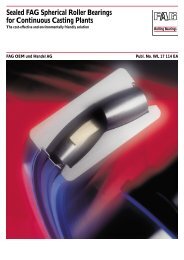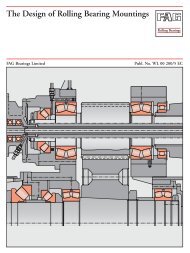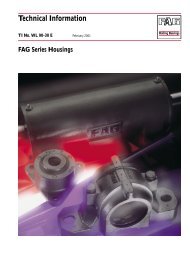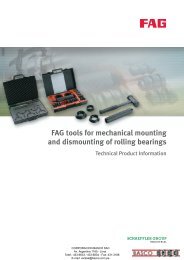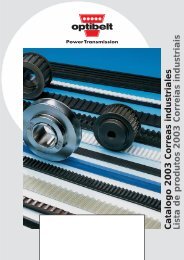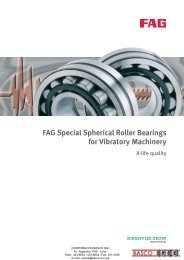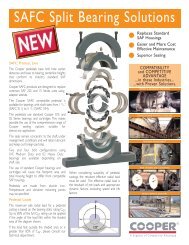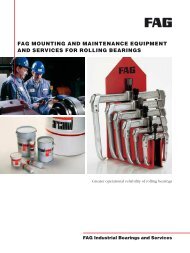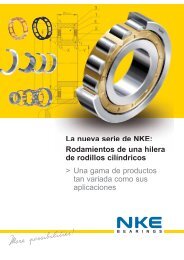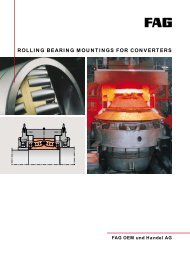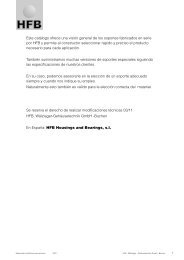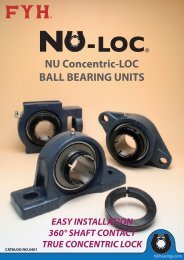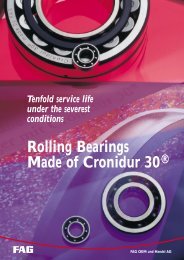75mm to 180mm SPLIT TAPERED BEARINGS
75mm to 180mm SPLIT TAPERED BEARINGS
75mm to 180mm SPLIT TAPERED BEARINGS
- No tags were found...
You also want an ePaper? Increase the reach of your titles
YUMPU automatically turns print PDFs into web optimized ePapers that Google loves.
<strong>75mm</strong> <strong>to</strong> <strong>180mm</strong>Split tapered BEARINGsBulkhead sealingIt is often found economical <strong>to</strong> combine a bearing andbulkhead seal in<strong>to</strong> one unit. This reduces the number ofindividual units required, and prevents problems with shafteccentricity sometimes encountered at the bulkhead seal whenit is separated from the bearing.Generally, a specially adapted flange mounting is used and thebearing is fitted with SRSRP seals (see page 6). Generally, theflange incorporates additional sealing <strong>to</strong> the cartridge seating,and may include sealing on the mounting face (‘backface’).Where the shaft surface speed is <strong>to</strong>o high for standardSRSRP seals, an alternative high speed version is available, oralternative seal types can be used if a moderate leakage ofwater is permitted through the bearing in an emergency.Sealing <strong>to</strong> flange mounting face (“BFS”)Sealing <strong>to</strong> swivel seating (“SSE”)SRSRP SealCombined bearing and bulkhead sealBearing SelectionBearing ratings for dynamic radial capacity (Cr) and static radialcapacity (Cor) shown in this leaflet are in accordance with ISO281-1990 and ISO 76-1987 respectively.Radial and axial loads must be considered <strong>to</strong>gether ascombined ‘equivalent loads’, as explained below. Generally,maximum instantaneous loading is governed by housingstrength rather than bearing static capacity.Dynamic ratingExpected bearing life is calculated by the following equation:L10 = [Cr/(P x fd)] (10/3)where:L10 = expected life of 90% of similar bearingsunder similar operating conditionsCr = radial dynamic ratingP = equivalent dynamic loadfd = dynamic or service fac<strong>to</strong>r, generally from1 for steady loading <strong>to</strong> 3.5 for heavy shock,reciprocation or vibrationThe dynamic equivalent load is calculated as follows:when F a /F r ≤e :when F a /F r >e :P = F r + Y 1 F aP = 0.67F r + Y 2 F awhere:F r = applied radial loadF a = applied axial loadand calculation fac<strong>to</strong>rs Y 1 , Y 2 and e are given in the productdata tables.Life calculation with multiple load conditionsWhere varying loads are experienced in operation, using themaximum load condition may lead <strong>to</strong> an unrealistically lowcalculated life. For n load conditions constituting the full loadcycle (at constant speed), an overall dynamic equivalent loadmay be calculated as follows:i=n0.3P = [∑P (10/3) i p i ]where:P ip ii=1= dynamic equivalent load under loadcondition i= proportion of time load condition i isapplicableWhere the load is continuously variable it may be brokendown in<strong>to</strong> a discrete approximation <strong>to</strong> the actual load cycle.Minimum loadingIn order <strong>to</strong> avoid excessive skidding of the rollers, sufficientloading must be applied <strong>to</strong> the bearing, as follows:P ≥ 0.01Cr2



